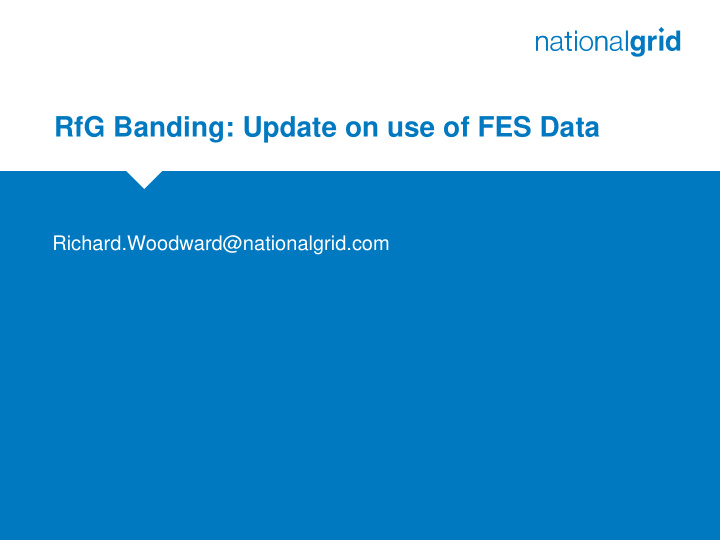



RfG Banding: Update on use of FES Data Richard.Woodward@nationalgrid.com
Topics Response to queries at last workgroup Recap on FES Distributed Generation by Type + Tx Gen (Type D) Link to System Operability Presentation by Ben Marshall (NGET) Time Frame for CBA Data Sources 2
Follow- ups on last month’s presentation What status do the interconnectors have for response provision; are they in/out of merit? At times of system constraint (e.g. summer minimum), FES assumes interconnector (I/C) physical flow to be neutral (0MW). The Irish I/Cs would be exporting from GB to Ireland however. At all other times the interconnectors flow dependant on prevailing market conditions (e.g. power prices) All interconnectors are considered in merit (e.g. commercially available) for response How is the FES criteria for in/out of merit determined? Due to commercial sensitivities involved, particularly as third party data is involved, the principles behind the ‘in/out of merit’ classification cannot be shared by the FES team 3
A recap on FES principles… 4
No Prog. – Distributed Gen Installed Capacity by RfG band (as per code) 60 50 40 Type D (All) Type C (All) GW Type B (All) 30 Type A (All) Micro Gen (incl some Type A) Nonwind NonSolar 20 Solar Wind 10 0 5
Slow Prog. – Distributed Gen Installed Capacity by RfG band (as per code) 60 50 40 Type D (All) Type C (All) GW Type B (All) 30 Type A (All) Micro Gen (incl some Type A) Nonwind NonSolar 20 Solar Wind 10 0 6
Gone Green – Distributed Gen Installed Capacity by RfG band (as per code) 60 50 40 Type D (All) Type C (All) Type B (All) GW 30 Type A (All) Micro Gen (incl some Type A) Nonwind NonSolar 20 Solar Wind 10 0 7
Consumer Power – Distributed Gen Installed Capacity by RfG band (as per code) 60 50 40 Type D (All) Type C (All) GW Type B (All) 30 Type A (All) MicroGen (incl some Type A) NonWind NonSolar 20 Solar Wind 10 0 8
No Prog. – Installed Capacity by RfG band (as per code) including Tx 160 140 120 Tx Gen (Type D) 100 Type D (All) Type C (All) GW 80 Type B (All) Type A (All) Micro Gen (incl some Type A) 60 Nonwind NonSolar Solar 40 Wind 20 0 9
Con. Power – Installed Capacity by RfG band (as per code) including Tx 160 140 120 Tx Gen (Type D) 100 Type D (All) Type C (All) GW 80 Type B (All) Type A (All) MicroGen (incl some Type A) 60 NonWind NonSolar Solar 40 Wind 20 0 10
FES 16… A new sensitivity on Consumer Power was included within the FES 15, which reflected additional Solar PV installation in the current year post-FES consultation This potentially would be incorporated into all four scenarios for FES 16, projecting a larger total than currently anticipated Installed Capacity 14/15 15/16 16/17 17/18 18/19 19/20 20/21 21/22 22/23 23/24 24/25 25/26 Solar PV 5709 8879 199 15193 18337 21295 23839 25739 27595 29399 31140 32778 Sensitivity (MW) 15 CP 4753 7039 9401 11672 13978 16145 18001 19376 716 218 23273 24452 11
Link to System Operability [Separate presentation by Ben Marshall] 12
Time Frame for CBA Data Sources 13
Time Frame for CBA Data Sources Which duration of future datasets should GC0048 base the initial setting of RfG banding thresholds on? (Rank in order of preference) Responses Total Count Total/Count Rank Up to 3 years 2 1 1 1 4 6 2 6 3 4 30 10 3.0 4 Up to 5 1 years 1 2 2 2 1 1 5 1 5 1 21 10 2.1 Up to 7 2 years 3 3 3 3 2 2 4 3 2 25 9 2.8 Up to 10 3 years 4 4 4 3 1 3 1 3 23 8 2.9 Up to 15 5 years 5 5 5 5 3 5 2 5 35 8 4.4 Up to 20 6 years 6 6 6 6 4 6 3 6 43 8 5.4 Please continue to respond at: https://www.surveymonkey.com/r/SRMKL9Q 14
Recommend
More recommend